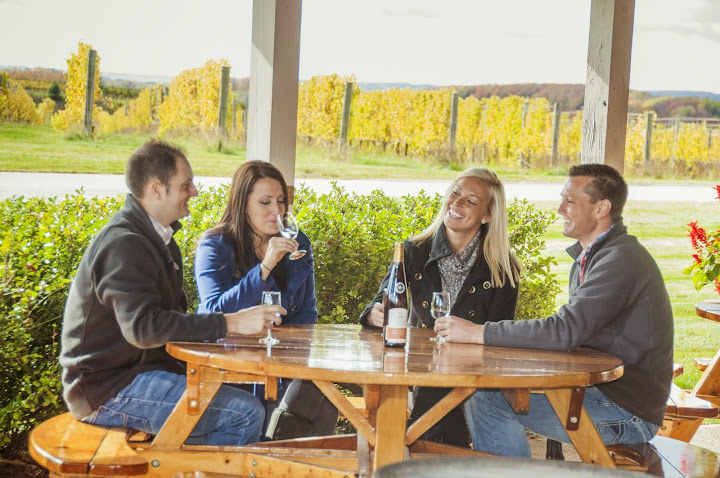In summertime, the highlands of Michigan’s Traverse City region are thick with cherry trees, their branches bowed down with bright red fruit. But when autumn arrives, everyone’s attention turns to a different crop.
Fall in these parts is the season of the wine harvest. From the middle of September until the first week of November, the region’s water-warmed slopes yield up fat dark clusters of grapes, destined to be tomorrow’s Chardonnays, Rieslings, and Pinot Grigios. And since the wine harvest takes place at the peak of northern Michigan’s fall color season, an autumn visit to the Traverse City area is a splendid way to pamper the eye and the palate at the same time.
Traverse City is fast becoming known for the clean, fresh taste of its wines, which hold their aroma and fruit flavors much more faithfully than those grown in hotter climates. Many of the area’s wineries boast awe-inspiring hilltop settings that have made them attractions in their own right. And autumn with its misty mornings, clear nights, and long golden afternoons may well be the most beautiful season of the year in the Traverse City wine country. That experience is only heightened by a view from the hilltop terrace of a winery like Chateau Chantal or Willow Vineyards, sipping from a glass of crisp Chardonnay while gazing across rows of thick grapevines at the deep blue water and the gold and scarlet hills beyond.

According to vintners like Mark Johnson of Chateau Chantal, the long deep lakes and roller-coaster hills that make Traverse City such a splendid setting for growing grapes are also the reason why this is one of the most popular year-round vacation destinations in the Great Lakes region.
“Grapes love beautiful places,” he says.

Thanks to the cool blue depths of nearby Grand Traverse Bay (and a mile-high glacier that plowed through the area 100,000 years ago), the area’s unique combination of climate, topography, and soils produce grapes that are sweeter and more flavorful than those grown farther south. But it’s also a stunningly beautiful place for touring.

Traverse City’s prime wine country is spread along the steep slopes of two peninsulas, each a distinct wine appellation area. The Leelanau Peninsula is a roughly triangular land mass along the Lake Michigan shore, while the narrower Old Mission Peninsula extends 20 miles into the center of Grand Traverse Bay. Renowned for their natural beauty, they’re able to take full advantage of Lake Michigan’s moderating influence on the climate.
Of course, there’s no way to visit all of the nearly 40 wineries and tasting rooms in Traverse City’s wine country in a single trip. The much more enjoyable approach is to take one of the smaller “wine trails” that highlight the landscapes and wines of particular areas, getting to know each place on its own terms.

The Leelanau Peninsula alone is home to more than 25 wineries – so many, in fact, that the local vintners’ association decided last year to divide their wine trail into three separate “loops” to make it easier for visitors to plan their trips and to encourage them to try some of what grower Matt Gregory calls the “hidden treasures of Michigan’s Wine Coast.”
The Grand Traverse Bay Loop (probably the most accessible to travelers staying in Traverse City) includes nine wineries along the east shore of the peninsula from Traverse City to Suttons Bay. It’s a lovely area encompassing a long stretch of beautiful shoreline, some marvelous hilltop views and a broad interior valley filled with orchards, vineyards. Cyclists can even tour some of these wineries on the nearby Leelanau Trail.
The Sleeping Bear Loop takes visitors to six wineries on the peninsula’s western shore. It contains some of the most beautiful countryside in Leelanau County, including the magnificent Sleeping Bear Dunes National Lakeshore, as well as the charming resort community of Glen Arbor and the vibrant inland villages of Cedar and Lake Leelanau.
The Northern Loop covers 10 wineries in the less congested northern half of the peninsula -- a place of great variety that includes quaint lakeport villages like Leland, Northport and Omena, remote beaches, rugged valleys and attractions like the century-old Grand Traverse Lighthouse.
The most easily defined trail in the region is on the Old Mission Peninsula. It’s just north of the Traverse City limits, and its eight wineries are surrounded by some of the region’s most beautiful scenery. It, too, has attractions of a non-culinary sort, including the historic village of Old Mission and the Mission Point Lighthouse.
For those who don’t have time to take a wine trail tour into the countryside, Traverse City also has one “urban winery” – Left Foot Charley, in the Village at Grand Traverse Commons. Although winemaker Bryan Ulbrich grows his grapes outside the city, the wines are all made on site in what was once the laundry building of Traverse City’s former mental asylum. And with its castle-like spires, golden brick buildings and forested campus, the Commons is quite scenic in its own right.
Learn more at http://www.traversecity.com
Photos courtesy and copyright Traverse City Tourism www.traversecity.com
Autumn, with its misty mornings, clear nights, and long golden afternoons may well be the most beautiful season of the year in the Traverse City wine country.
Posted by: Jessica Voigts
